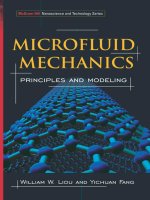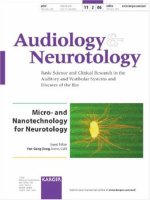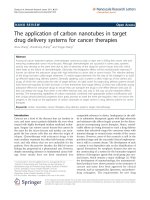- Trang chủ >>
- Khoa Học Tự Nhiên >>
- Vật lý
nanoparticle technology for drug delivery, 2006, p.427
Bạn đang xem bản rút gọn của tài liệu. Xem và tải ngay bản đầy đủ của tài liệu tại đây (4.28 MB, 427 trang )
DRUGS AND THE PHARMACEUTICAL SCIENCES
A Series of Textbooks and Monographs
1. Pharmacokinetics,
Milo Gibaldi and Donald Perrier
2. Good Manufacturing Practices for Pharmaceuticals: A Plan for Total
Quality Control,
Sidney H. Willig, Murray M. Tuckerman,
and William S. Hitchings IV
3. Microencapsulation,
edited by J. R. Nixon
4. Drug Metabolism: Chemical and Biochemical Aspects,
Bernard Testa
and Peter Jenner
5. New Drugs: Discovery and Development,
edited by Alan A. Rubin
6. Sustained and Controlled Release Drug Delivery Systems,
edited by
Joseph R. Robinson
7. Modern Pharmaceutics,
edited by Gilbert S. Banker
and Christopher T. Rhodes
8. Prescription Drugs in Short Supply: Case Histories,
Michael A. Schwartz
9. Activated Charcoal: Antidotal and Other Medical Uses,
David O. Cooney
10. Concepts in Drug Metabolism (in two parts),
edited by Peter Jenner
and Bernard Testa
11. Pharmaceutical Analysis: Modern Methods (in two parts),
edited by
James W. Munson
12. Techniques of Solubilization of Drugs,
edited by Samuel H. Yalkowsky
13. Orphan Drugs,
edited by Fred E. Karch
14. Novel Drug Delivery Systems: Fundamentals, Developmental Concepts,
Biomedical Assessments,
Yie W. Chien
15. Pharmacokinetics: Second Edition, Revised and Expanded,
Milo Gibaldi
and Donald Perrier
16. Good Manufacturing Practices for Pharmaceuticals: A Plan for Total
Quality Control, Second Edition, Revised and Expanded,
Sidney H. Willig,
Murray M. Tuckerman, and William S. Hitchings IV
17. Formulation of Veterinary Dosage Forms,
edited by Jack Blodinger
18. Dermatological Formulations: Percutaneous Absorption,
Brian W. Barry
19. The Clinical Research Process in the Pharmaceutical Industry,
edited by
Gary M. Matoren
20. Microencapsulation and Related Drug Processes,
Patrick B. Deasy
21. Drugs and Nutrients: The Interactive Effects,
edited by Daphne A. Roe
and T. Colin Campbell
22. Biotechnology of Industrial Antibiotics,
Erick J. Vandamme
23. Pharmaceutical Process Validation,
edited by Bernard T. Loftus
and Robert A. Nash
DK5687_half-series-title.qxd 11/17/05 8:57 AM Page C
24. Anticancer and Interferon Agents: Synthesis and Properties,
edited by
Raphael M. Ottenbrite and George B. Butler
25. Pharmaceutical Statistics: Practical and Clinical Applications,
Sanford Bolton
26. Drug Dynamics for Analytical, Clinical, and Biological Chemists,
Benjamin J. Gudzinowicz, Burrows T. Younkin, Jr.,
and Michael J. Gudzinowicz
27. Modern Analysis of Antibiotics,
edited by Adjoran Aszalos
28. Solubility and Related Properties,
Kenneth C. James
29. Controlled Drug Delivery: Fundamentals and Applications, Second Edition,
Revised and Expanded,
edited by Joseph R. Robinson and Vincent H. Lee
30. New Drug Approval Process: Clinical and Regulatory Management,
edited by Richard A. Guarino
31. Transdermal Controlled Systemic Medications,
edited by Yie W. Chien
32. Drug Delivery Devices: Fundamentals and Applications,
edited by
Praveen Tyle
33. Pharmacokinetics: Regulatory • Industrial • Academic Perspectives,
edited by Peter G. Welling and Francis L. S. Tse
34. Clinical Drug Trials and Tribulations,
edited by Allen E. Cato
35. Transdermal Drug Delivery: Developmental Issues and Research
Initiatives,
edited by Jonathan Hadgraft and Richard H. Guy
36. Aqueous Polymeric Coatings for Pharmaceutical Dosage Forms,
edited by James W. McGinity
37. Pharmaceutical Pelletization Technology,
edited by Isaac Ghebre-Sellassie
38. Good Laboratory Practice Regulations,
edited by Allen F. Hirsch
39. Nasal Systemic Drug Delivery,
Yie W. Chien, Kenneth S. E. Su,
and Shyi-Feu Chang
40. Modern Pharmaceutics: Second Edition, Revised and Expanded,
edited by Gilbert S. Banker and Christopher T. Rhodes
41. Specialized Drug Delivery Systems: Manufacturing and Production
Technology,
edited by Praveen Tyle
42. Topical Drug Delivery Formulations,
edited by David W. Osborne
and Anton H. Amann
43. Drug Stability: Principles and Practices,
Jens T. Carstensen
44. Pharmaceutical Statistics: Practical and Clinical Applications,
Second Edition, Revised and Expanded,
Sanford Bolton
45. Biodegradable Polymers as Drug Delivery Systems,
edited by
Mark Chasin and Robert Langer
46. Preclinical Drug Disposition: A Laboratory Handbook,
Francis L. S. Tse
and James J. Jaffe
47. HPLC in the Pharmaceutical Industry,
edited by Godwin W. Fong
and Stanley K. Lam
DK5687_half-series-title.qxd 11/17/05 8:57 AM Page D
48. Pharmaceutical Bioequivalence,
edited by Peter G. Welling,
Francis L. S. Tse, and Shrikant V. Dinghe
49. Pharmaceutical Dissolution Testing,
Umesh V. Banakar
50. Novel Drug Delivery Systems: Second Edition, Revised and Expanded,
Yie W. Chien
51. Managing the Clinical Drug Development Process,
David M. Cocchetto
and Ronald V. Nardi
52. Good Manufacturing Practices for Pharmaceuticals: A Plan for Total
Quality Control, Third Edition,
edited by Sidney H. Willig
and James R. Stoker
53. Prodrugs: Topical and Ocular Drug Delivery,
edited by Kenneth B. Sloan
54. Pharmaceutical Inhalation Aerosol Technology,
edited by
Anthony J. Hickey
55. Radiopharmaceuticals: Chemistry and Pharmacology,
edited by
Adrian D. Nunn
56. New Drug Approval Process: Second Edition, Revised and Expanded,
edited by Richard A. Guarino
57. Pharmaceutical Process Validation: Second Edition, Revised
and Expanded,
edited by Ira R. Berry and Robert A. Nash
58. Ophthalmic Drug Delivery Systems,
edited by Ashim K. Mitra
59. Pharmaceutical Skin Penetration Enhancement,
edited by
Kenneth A. Walters and Jonathan Hadgraft
60. Colonic Drug Absorption and Metabolism,
edited by Peter R. Bieck
61. Pharmaceutical Particulate Carriers: Therapeutic Applications,
edited by
Alain Rolland
62. Drug Permeation Enhancement: Theory and Applications,
edited by
Dean S. Hsieh
63. Glycopeptide Antibiotics,
edited by Ramakrishnan Nagarajan
64. Achieving Sterility in Medical and Pharmaceutical Products,
Nigel A. Halls
65. Multiparticulate Oral Drug Delivery,
edited by Isaac Ghebre-Sellassie
66. Colloidal Drug Delivery Systems,
edited by Jörg Kreuter
67. Pharmacokinetics: Regulatory • Industrial • Academic Perspectives,
Second Edition,
edited by Peter G. Welling and Francis L. S. Tse
68. Drug Stability: Principles and Practices, Second Edition, Revised
and Expanded,
Jens T. Carstensen
69. Good Laboratory Practice Regulations: Second Edition, Revised
and Expanded,
edited by Sandy Weinberg
70. Physical Characterization of Pharmaceutical Solids,
edited by
Harry G. Brittain
71. Pharmaceutical Powder Compaction Technology,
edited by
Göran Alderborn and Christer Nyström
DK5687_half-series-title.qxd 11/17/05 8:57 AM Page E
72. Modern Pharmaceutics: Third Edition, Revised and Expanded,
edited by
Gilbert S. Banker and Christopher T. Rhodes
73. Microencapsulation: Methods and Industrial Applications,
edited by
Simon Benita
74. Oral Mucosal Drug Delivery,
edited by Michael J. Rathbone
75. Clinical Research in Pharmaceutical Development,
edited by Barry Bleidt
and Michael Montagne
76. The Drug Development Process: Increasing Efficiency and Cost
Effectiveness,
edited by Peter G. Welling, Louis Lasagna,
and Umesh V. Banakar
77. Microparticulate Systems for the Delivery of Proteins and Vaccines,
edited by Smadar Cohen and Howard Bernstein
78. Good Manufacturing Practices for Pharmaceuticals: A Plan for Total
Quality Control, Fourth Edition, Revised and Expanded,
Sidney H. Willig
and James R. Stoker
79. Aqueous Polymeric Coatings for Pharmaceutical Dosage Forms:
Second Edition, Revised and Expanded,
edited by James W. McGinity
80. Pharmaceutical Statistics: Practical and Clinical Applications,
Third Edition,
Sanford Bolton
81. Handbook of Pharmaceutical Granulation Technology,
edited by
Dilip M. Parikh
82. Biotechnology of Antibiotics: Second Edition, Revised and Expanded,
edited by William R. Strohl
83. Mechanisms of Transdermal Drug Delivery,
edited by Russell O. Potts
and Richard H. Guy
84. Pharmaceutical Enzymes,
edited by Albert Lauwers and Simon Scharpé
85. Development of Biopharmaceutical Parenteral Dosage Forms,
edited by
John A. Bontempo
86. Pharmaceutical Project Management,
edited by Tony Kennedy
87. Drug Products for Clinical Trials: An International Guide to Formulation •
Production • Quality Control,
edited by Donald C. Monkhouse
and Christopher T. Rhodes
88. Development and Formulation of Veterinary Dosage Forms:
Second Edition, Revised and Expanded,
edited by Gregory E. Hardee
and J. Desmond Baggot
89. Receptor-Based Drug Design,
edited by Paul Leff
90. Automation and Validation of Information in Pharmaceutical Processing,
edited by Joseph F. deSpautz
91. Dermal Absorption and Toxicity Assessment,
edited by Michael S. Roberts
and Kenneth A. Walters
92. Pharmaceutical Experimental Design,
Gareth A. Lewis, Didier Mathieu,
and Roger Phan-Tan-Luu
93. Preparing for FDA Pre-Approval Inspections,
edited by Martin D. Hynes III
DK5687_half-series-title.qxd 11/17/05 8:57 AM Page F
94. Pharmaceutical Excipients: Characterization by IR, Raman, and NMR
Spectroscopy,
David E. Bugay and W. Paul Findlay
95. Polymorphism in Pharmaceutical Solids,
edited by Harry G. Brittain
96. Freeze-Drying/Lyophilization of Pharmaceutical and Biological Products,
edited by Louis Rey and Joan C. May
97. Percutaneous Absorption: Drugs–Cosmetics–Mechanisms–Methodology,
Third Edition, Revised and Expanded,
edited by Robert L. Bronaugh
and Howard I. Maibach
98. Bioadhesive Drug Delivery Systems: Fundamentals, Novel Approaches,
and Development,
edited by Edith Mathiowitz, Donald E. Chickering III,
and Claus-Michael Lehr
99. Protein Formulation and Delivery,
edited by Eugene J. McNally
100. New Drug Approval Process: Third Edition, The Global Challenge,
edited by Richard A. Guarino
101. Peptide and Protein Drug Analysis,
edited by Ronald E. Reid
102. Transport Processes in Pharmaceutical Systems,
edited by
Gordon L. Amidon, Ping I. Lee, and Elizabeth M. Topp
103. Excipient Toxicity and Safety,
edited by Myra L. Weiner
and Lois A. Kotkoskie
104. The Clinical Audit in Pharmaceutical Development,
edited by
Michael R. Hamrell
105. Pharmaceutical Emulsions and Suspensions,
edited by Francoise Nielloud
and Gilberte Marti-Mestres
106. Oral Drug Absorption: Prediction and Assessment,
edited by
Jennifer B. Dressman and Hans Lennernäs
107. Drug Stability: Principles and Practices, Third Edition, Revised
and Expanded,
edited by Jens T. Carstensen and C. T. Rhodes
108. Containment in the Pharmaceutical Industry,
edited by James P. Wood
109. Good Manufacturing Practices for Pharmaceuticals: A Plan for Total
Quality Control from Manufacturer to Consumer, Fifth Edition, Revised
and Expanded,
Sidney H. Willig
110. Advanced Pharmaceutical Solids,
Jens T. Carstensen
111. Endotoxins: Pyrogens, LAL Testing, and Depyrogenation, Second Edition,
Revised and Expanded,
Kevin L. Williams
112. Pharmaceutical Process Engineering,
Anthony J. Hickey
and David Ganderton
113. Pharmacogenomics,
edited by Werner Kalow, Urs A. Meyer
and Rachel F. Tyndale
114. Handbook of Drug Screening,
edited by Ramakrishna Seethala
and Prabhavathi B. Fernandes
115. Drug Targeting Technology: Physical • Chemical • Biological Methods,
edited by Hans Schreier
116. Drug–Drug Interactions,
edited by A. David Rodrigues
DK5687_half-series-title.qxd 11/17/05 8:57 AM Page G
117. Handbook of Pharmaceutical Analysis,
edited by Lena Ohannesian
and Anthony J. Streeter
118. Pharmaceutical Process Scale-Up,
edited by Michael Levin
119. Dermatological and Transdermal Formulations,
edited by
Kenneth A. Walters
120. Clinical Drug Trials and Tribulations: Second Edition, Revised
and Expanded,
edited by Allen Cato, Lynda Sutton, and Allen Cato III
121. Modern Pharmaceutics: Fourth Edition, Revised and Expanded,
edited by
Gilbert S. Banker and Christopher T. Rhodes
122. Surfactants and Polymers in Drug Delivery,
Martin Malmsten
123. Transdermal Drug Delivery: Second Edition, Revised and Expanded,
edited by Richard H. Guy and Jonathan Hadgraft
124. Good Laboratory Practice Regulations: Second Edition, Revised
and Expanded,
edited by Sandy Weinberg
125. Parenteral Quality Control: Sterility, Pyrogen, Particulate, and Package
Integrity Testing: Third Edition, Revised and Expanded,
Michael J. Akers,
Daniel S. Larrimore, and Dana Morton Guazzo
126. Modified-Release Drug Delivery Technology,
edited by
Michael J. Rathbone, Jonathan Hadgraft, and Michael S. Roberts
127. Simulation for Designing Clinical Trials: A Pharmacokinetic-
Pharmacodynamic Modeling Perspective,
edited by Hui C. Kimko
and Stephen B. Duffull
128. Affinity Capillary Electrophoresis in Pharmaceutics and Biopharmaceutics,
edited by Reinhard H. H. Neubert and Hans-Hermann Rüttinger
129. Pharmaceutical Process Validation: An International Third Edition,
Revised and Expanded,
edited by Robert A. Nash and Alfred H. Wachter
130. Ophthalmic Drug Delivery Systems: Second Edition, Revised
and Expanded,
edited by Ashim K. Mitra
131. Pharmaceutical Gene Delivery Systems,
edited by Alain Rolland
and Sean M. Sullivan
132. Biomarkers in Clinical Drug Development,
edited by John C. Bloom
and Robert A. Dean
133. Pharmaceutical Extrusion Technology,
edited by Isaac Ghebre-Sellassie
and Charles Martin
134. Pharmaceutical Inhalation Aerosol Technology: Second Edition,
Revised and Expanded,
edited by Anthony J. Hickey
135. Pharmaceutical Statistics: Practical and Clinical Applications,
Fourth Edition,
Sanford Bolton and Charles Bon
136. Compliance Handbook for Pharmaceuticals, Medical Devices,
and Biologics,
edited by Carmen Medina
137. Freeze-Drying/Lyophilization of Pharmaceutical and Biological Products:
Second Edition, Revised and Expanded,
edited by Louis Rey
and Joan C. May
DK5687_half-series-title.qxd 11/17/05 8:57 AM Page H
138. Supercritical Fluid Technology for Drug Product Development,
edited by
Peter York, Uday B. Kompella, and Boris Y. Shekunov
139. New Drug Approval Process: Fourth Edition, Accelerating Global
Registrations,
edited by Richard A. Guarino
140. Microbial Contamination Control in Parenteral Manufacturing,
edited by
Kevin L. Williams
141. New Drug Development: Regulatory Paradigms for Clinical Pharmacology
and Biopharmaceutics,
edited by Chandrahas G. Sahajwalla
142. Microbial Contamination Control in the Pharmaceutical Industry,
edited by
Luis Jimenez
143. Generic Drug Product Development: Solid Oral Dosage Forms
, edited by
Leon Shargel and Izzy Kanfer
144. Introduction to the Pharmaceutical Regulatory Process
, edited by
Ira R. Berry
145. Drug Delivery to the Oral Cavity: Molecules to Market,
edited by
Tapash K. Ghosh and William R. Pfister
146. Good Design Practices for GMP Pharmaceutical Facilities
, edited by
Andrew Signore and Terry Jacobs
147. Drug Products for Clinical Trials, Second Edition
, edited by Donald
Monkhouse, Charles Carney, and Jim Clark
148. Polymeric Drug Delivery Systems,
edited by Glen S. Kwon
149. Injectable Dispersed Systems: Formulation, Processing, and Performance,
edited by Diane J. Burgess
150. Laboratory Auditing for Quality and Regulatory Compliance,
Donald Singer, Raluca-Ioana Stefan, and Jacobus van Staden
151. Active Pharmaceutical Ingredients: Development, Manufacturing,
and Regulation,
edited by Stanley Nusim
152. Preclinical Drug Development,
edited by Mark C. Rogge and David R. Taft
153. Pharmaceutical Stress Testing: Predicting Drug Degradation,
edited by
Steven W. Baertschi
154. Handbook of Pharmaceutical Granulation Technology: Second Edition,
edited by Dilip M. Parikh
155. Percutaneous Absorption: Drugs–Cosmetics–Mechanisms–Methodology,
Fourth Edition,
edited by Robert L. Bronaugh and Howard I. Maibach
156. Pharmacogenomics: Second Edition,
edited by Werner Kalow,
Urs A. Meyer and Rachel F. Tyndale
157. Pharmaceutical Process Scale-Up, Second Edition,
edited by
Michael Levin
158. Microencapsulation: Methods and Industrial Applications, Second Edition,
edited by Simon Benita
159. Nanoparticle Technology for Drug Delivery,
edited by Ram B. Gupta
and Uday B. Kompella
DK5687_half-series-title.qxd 11/17/05 8:57 AM Page I
Nanoparticle Technology
for Drug Delivery
edited by
Ram B. Gupta
Auburn University
Auburn, Alabama
Uday B. Kompella
University of Nebraska Medical Center
Omaha, Nebraska
New York London
DK5687_half-series-title.qxd 11/17/05 8:57 AM Page i
Published in 2006 by
Taylor & Francis Group
270 Madison Avenue
New York, NY 10016
© 2006 by Taylor & Francis Group, LLC
No claim to original U.S. Government works
Printed in the United States of America on acid-free paper
10987654321
International Standard Book Number-10: 1-57444-857-9 (Hardcover)
International Standard Book Number-13: 978-1-57444-857-3 (Hardcover)
This book contains information obtained from authentic and highly regarded sources. Reprinted material is
quoted with permission, and sources are indicated. A wide variety of references are listed. Reasonable efforts
have been made to publish reliable data and information, but the author and the publisher cannot assume
responsibility for the validity of all materials or for the consequences of their use.
No part of this book may be reprinted, reproduced, transmitted, or utilized in any form by any electronic,
mechanical, or other means, now known or hereafter invented, including photocopying, microfilming, and
recording, or in any information storage or retrieval system, without written permission from the publishers.
For permission to photocopy or use material electronically from this work, please access www.copyright.com
( or contact the Copyright Clearance Center, Inc. (CCC) 222 Rosewood Drive,
Danvers, MA 01923, 978-750-8400. CCC is a not-for-profit organization that provides licenses and registration
for a variety of users. For organizations that have been granted a photocopy license by the CCC, a separate
system of payment has been arranged.
Trademark Notice: Product or corporate names may be trademarks or registered trademarks, and are used only
for identification and explanation without intent to infringe.
Library of Congress Cataloging-in-Publication Data
Catalog record is available from the Library of Congress
Visit the Taylor & Francis Web site at
Taylor & Francis Group
is the Academic Division of Informa plc.
DK5687_Discl.fm Page 1 Tuesday, November 15, 2005 11:40 AM
Preface
Products of nanotechnology are expected to revolutionize
modern medicine, as evidenced by recent scientific advances
and global initiatives to support nanotechnology and nano-
medicine research. The field of drug delivery is a direct bene-
ficiary of these advancements. Due to their versatility in
targeting tissues, accessing deep molecular targets, and con-
trolling drug release, nanoparticles are helping address chal-
lenges to face the delivery of modern, as well as conventional
drugs. Since the majority of drug products employ solids,
nanoparticles are expected to have a broad impact on drug
product development. The purpose of this book is to present
practical issues in the manufacturing and biological applica-
tion of nanoparticles. Drug delivery scientists in industry,
academia, and regulatory agencies, as well as students in bio-
medical engineering, chemical engineering, pharmaceutical
sciences, and other sciences with an interest in drug delivery,
iii
will find this book useful. It can also be used as a textbook for
drug delivery courses focusing on nanoparticles.
This book is organized into four sections. The first section
describes the distinguishing fundamental properties of nano-
particles (Chap. 1) as well as technologies for nanoparticle
manufacturing (Chaps. 2–4). Nanoparticles can be manufac-
tured by either breaking macro-particles using technologies
such as milling and homogenization (Chap. 2) or by building
particles from molecules dissolved in a solution using super-
critical fluid technology (Chap. 3). Nanoparticle manufacturing
and properties can be further optimized by employing poly-
mers or proteins as stabilizers (Chap. 4).
The second section describes the characterization of nano-
particles at the material or physicochemical level (Chap. 5) and
relates these properties to the delivery and effectiveness of
nanoparticles (Chap. 6) as well as toxicological characteristics
(Chap. 7).
The third section presents the various applications of
nanoparticles in drug delivery. Depending on the route and
purpose of drug delivery, the requirements for nanoparticulate
systems can vary. These aspects are discussed in Chapter 8 for
injectable delivery, Chapter 9 for oral delivery, Chapter 10 for
brain delivery, Chapter 11 for ocular delivery, and Chapter 12
for gene delivery.
Finally, the fourth section provides an overview of the
clinical, ethical, and regulatory issues of nanoparticle-based
drug delivery. These are evolving areas and the drug product
development experience with nanoparticles is limited. As
more data is gathered on the safety and efficacy of nanoparti-
culate systems, a clearer view will emerge.
Preparation of this book would not have been possible
without the valuable contributions from various experts in
the field. We deeply appreciate their timely contributions.
Also, we are thankful to our colleagues at Auburn University
and the University of Nebraska Medical Center for their
support in preparing this book.
Ram B. Gupta
Uday B. Kompella
iv Preface
Contents
Preface . . . . iii
Contributors . . . . xi
PART I: TECHNOLOGIES FOR NANOPARTICLE
MANUFACTURING
1. Fundamentals of Drug Nanoparticles . . . . . . . . 1
Ram B. Gupta
Introduction . . . . 1
Nanoparticle Size . . . . 2
Nanoparticle Surface . . . . 3
Nanoparticle Suspension and Settling . . . . 4
Magnetic and Optical Properties . . . . 6
Production of Nanoparticles . . . . 6
Biological Transport of Nanoparticles . . . . 12
Conclusions . . . . 17
References . . . . 18
v
2. Manufacturing of Nanoparticles by Milling
and Homogenization Techniques . 21
Rainer H. Mu€ller, Jan Mo€schwitzer, and
Faris Nadiem Bushrab
Introduction . . . . 21
Pearl/Ball-Milling Technology for the Production of
Drug Nanocrystals . . . . 25
Drug Nanocrystals Produced by
High-Pressure Homogenization . . . . 28
Production of Drug Nanocrystal Compounds by
Spray-Drying . . . . 33
Production in Nonaqueous Liquids . . . . 35
Production in Hot-Melted Matrices . . . . 37
Pelletization Techniques . . . . 41
Direct Compress . . . . 45
References . . . . 47
3. Supercritical Fluid Technology for
Particle Engineering . . . . 53
Ram B. Gupta
Introduction . . . . 53
Supercritical CO
2
54
Solubility in Supercritical CO
2
55
Rapid Expansion of Supercritical Solution for
Particle Formation . . . . 59
RESS with Solid Cosolvent for Nanoparticle
Formation . . . . 63
Supercritical Antisolvent Process for Particle
Formation . . . . 66
SAS with Enhanced Mass (EM) Transfer
(SAS-EM) Process for Nanoparticle
Formation . . . . 69
Fundamentals Governing Particle Formation with
RESS and SAS . . . . 70
Other Applications of SCFs for
Particle Engineering . . . . 74
Safety and Health Issues . . . . 78
Conclusions . . . . 78
References . . . . 79
vi Contents
4. Polymer or Protein Stabilized Nanoparticles
from Emulsions . . . . . 85
Ram B. Gupta
Introduction . . . . 85
Emulsification Solvent Evaporation Process . . . . 86
Emulsification . . . . 87
Nanoparticle Hardening . . . . 93
Residual Solvent and Emulsifier . . . . 97
Protein Stabilized Nanoparticles . . . . 98
Conclusions . . . . 99
References . . . . 101
PART II: NANOPARTICLE CHARACTERIZATION
AND PROPERTIES
5. Physical Characterization of Nanoparticles . . . 103
Roy J. Haskell
Introduction . . . . 103
Measurement of Size . . . . 105
Available Methods . . . . 109
In Vitro Release . . . . 119
Example: Particle Size . . . . 121
Conclusions . . . . 130
References . . . . 132
6. Nanoparticle Interface: An Important
Determinant in Nanoparticle-Mediated
Drug/Gene Delivery . . 139
Sanjeeb K. Sahoo and Vinod Labhasetwar
Introduction . . . . 139
Influence of Emulsifier on
Pharmaceutical
Properties of Nanoparticles . . . . 140
Implication on Cellular Uptake/Toxicity/Gene
Delivery . . . . 148
Biodistribution . . . . 153
Conclusions . . . . 154
References . . . . 154
Contents vii
7. Toxicological Characterization of Engineered
Nanoparticles . . . 161
Paul J. A. Borm and Roel P. F. Schins
Introduction . . . . 161
Inhalation of Particles . . . . 164
Effects of Nanoparticles . . . . 170
Screening Engineered NP for Toxicological
Hazards . . . . 178
Conclusion . . . . 187
References . . . . 188
PART III: DRUG DELIVERY APPLICATIONS OF
NANOPARTICLES
8. Injectable Nanoparticles for Efficient Drug
Delivery . . . 199
Barrett Rabinow and Mahesh V. Chaubal
Introduction: Medical Needs Addressable by
Nanoparticulate Drug Delivery . . . . 199
Types of Carriers . . . . 209
Coating Functionality . . . . 215
External Assistance in Targeting . . . . 215
Drugs Incorporated . . . . 216
Clinical Development . . . . 217
Conclusions . . . . 220
References . . . . 221
9. Polymeric Nanoparticles for Oral Drug
Delivery . . . 231
Vivekanand Bhardwaj and Majeti Naga Venkata Ravi
Kumar
Introduction . . . . 231
Physiology of GIT with Relevance to Particulate
Uptake . . . . 232
Particle Size and Surface Charge: Critical Factors in
Particle Absorption . . . . 236
Bioadhesion . . . . 237
Tracer Techniques . . . . 241
viii Contents
In Vitro and In Vivo Models . . . . 243
Nanoparticle Formulation . . . . 244
Applications . . . . 253
Future Directions . . . . 260
References . . . . 262
10. Brain Delivery by Nanoparticles . . 273
Svetlana Gelperina
Introduction . . . . 273
Biodistribution Studies . . . . 276
Pharmacological Activity . . . . 289
Mechanisms of Drug Delivery to the Brain by
Means of Polymeric NP . . . . 296
Conclusions . . . . 309
References . . . . 311
11. Nanoparticles for Ocular Drug Delivery . . . . . 319
Aniruddha C. Amrite and Uday B. Kompella
Introduction . . . . 319
Disposition of Nanoparticles in the Eye . . . . 322
Ocular Drug Delivery Enhancement Using
Nanoparticles . . . . 336
Safety and Tolerability of Particulate
Systems . . . . 347
Conclusions . . . . 352
References . . . . 353
12. DNA Nanoparticle Gene Delivery Systems . . . 361
Moses O. Oyewumi and Kevin G. Rice
Gene Delivery Vectors . . . . 361
Polymers Used to Prepare DNA
Nanoparticles . . . . 363
Physical Properties of DNA Nanoparticles . . . . 365
Biodistribution and Trafficking of DNA
Nanoparticles . . . . 371
Conclusions . . . . 372
References . . . . 373
Contents ix
PART IV: CLINICAL, ETHICAL, AND
REGULATORY ISSUES
13. Nanotechnology and Nanoparticles: Clinical,
Ethical, and Regulatory Issues . . 381
Makena Hammond and Uday B. Kompella
Introduction . . . . 381
Clinical Aspects . . . . 382
Environmental, Social, and
Ethical Issues . . . . 385
Regulatory Challenges . . . . 388
Conclusions . . . . 392
References . . . . 393
Index . . . . 397
x Contents
Contributors
Aniruddha C. Amrite Department of Pharmaceutical
Sciences, University of Nebraska Medical Center, Omaha,
Nebraska, U.S.A.
Vivekanand Bhardwaj Department of Pharmaceutics, National
Institute of Pharmaceutical Education and Research, Punjab,
India
Paul J. A. Borm Centre of Expertise in Life Sciences,
Zuyd University, Heerlen, The Netherlands
Faris Nadiem Bushrab Department of Pharmaceutical
Technology, Biotechnology and Quality Management, Freie
Universita
¨
t, Berlin, Germany
Mahesh V. Chaubal BioPharma Solutions, Baxter Healthcare,
Round Lake, Illinois, U.S.A.
xi
Svetlana Gelperina Institute of Molecular Medicine, Moscow
Sechenov Medical Academy, Moscow, Russia
Ram B. Gupta Department of Chemical Engineering, Auburn
University, Auburn, Alabama, U.S.A.
Makena Hammond College of Pharmacy, University of
Nebraska Medical Center, Omaha, Nebraska, and Virginia State
University, Petersburg, Virginia, U.S.A.
Roy J. Haskell Pfizer Corporation, Michigan Pharmaceutical
Sciences, Kalamazoo, Michigan, U.S.A.
Uday B. Kompella Department of Pharmaceutical Sciences,
College of Pharmacy, University of Nebraska Medical Center,
Omaha, Nebraska, U.S.A.
Majeti Naga Venkata Ravi Kumar Department of
Pharmaceutics, National Institute of Pharmaceutical Education
and Research, Punjab, India
Vinod Labhasetwar Department of Pharmaceutical Sciences,
University of Nebraska Medical Center, Omaha, Nebraska, U.S.A.
Jan Mo
¨
schwitzer Department of Pharmaceutical Technology,
Biotechnology and Quality Management, Freie Universita
¨
t, Berlin,
Germany
Rainer H. Mu
¨
ller Department of Pharmaceutical Technology,
Biotechnology and Quality Management, Freie Universita
¨
t, Berlin,
Germany
Moses O. Oyew umi Division of Medicinal and Natural Products
Chemistry, College of Pharmacy, University of Iowa, Iowa City,
Iowa, U.S.A.
Barrett Rabinow BioPharma Solutions, Baxter Healthcare,
Round Lake, Illinois, U.S.A.
Kevin G. Rice Division of Medicinal and Natural Products
Chemistry, College of Pharmacy, University of Iowa, Iowa City,
Iowa, U.S.A.
xii Contributors
Sanjeeb K. Sahoo Department of Pharmaceutical Sciences,
University of Nebraska Medical Center, Omaha, Nebraska, U.S.A.
Roel P. F. Schins Institut fur Umweltmedizinische Forschung
(IUF), University of Du¨ sseldorf, Du¨ sseldorf, Germany
Contributors xiii
1
Fundamentals of Drug Nanoparticles
RAM B. GUPTA
Department of Chemical Engineering,
Auburn University, Auburn, Alabama, U.S.A.
INTRODUCTION
In pharmaceutics, %90% of all medicines, the active ingredi-
ent is in the form of solid particles. With the development in
nanotechnology, it is now possible to produce drug nanoparti-
cles that can be utilized in a variety of innovative ways. New
drug delivery pathways can now be used that can increase
drug efficacy and reduce side effects. For example, in 2005,
the U.S. Food and Drug Administration approved intra-
venously administered 130-nm albumin nanoparticles loaded
with paclitaxel (Abraxane
TM
) for cancer therapy, which epito-
mizes the new products anticipated based on nanoparticulate
systems. The new albumin/paclitaxel–nanoparticle formula-
tion offers several advantages including elimination of
PART I: TECHNOLOGIES FOR
NANOPARTICLE MANUFACTURING
1
toxicity because of cremophor, a solvent used in the previous
formulation, and improved efficacy due to the greater dose of
the drug that can be administered and delivered. For better
development of the nanoparticulate systems, it is essential to
understand the pharmaceutically relevant properties of nano-
particles, which is the purpose of this chapter and this book
in general. In the following narrative, some fundamental prop-
erties of nanoparticles including their size, surface area, set-
tling velocity, magnetic and optical properties, and biological
transport are brought into the perspective of drug delivery.
NANOPARTICLE SIZE
To put the size of nanoparticles in perspective, Table 1 com-
pares sizes of various objects. Because of the comparable size
of the components in the human cells, nanoparticles are of
great interest in drug delivery. It appears that nature, in
making the biological systems, has extensively used nan-
ometer scale. If one has to go hand in hand with nature in
treating the diseases one needs to use the same scale, whether
it is correcting a faulty gene, killing leprosy bacteria sitting
inside the body cells, blocking the multiplication of viral gen-
ome, killing a cancer cell, repairing the cellular metabolism,
or preventing wrinkles or other signs of aging. One cannot
use a human arm to massage the hurt leg of an ant. Size
matching is important in carrying out any activity. Drug
delivery is aimed at influencing the biochemistry of the body.
Table 1 Typical Size of Various Objects
Object Size (nm)
Carbon atom 0.1
DNA double helix (diameter) 3
Ribosome 10
Virus 100
Bacterium 1,000
Red blood cell 5,000
Human hair (diameter) 50,000
Resolution of unaided human eyes 100,000
2 Gupta









